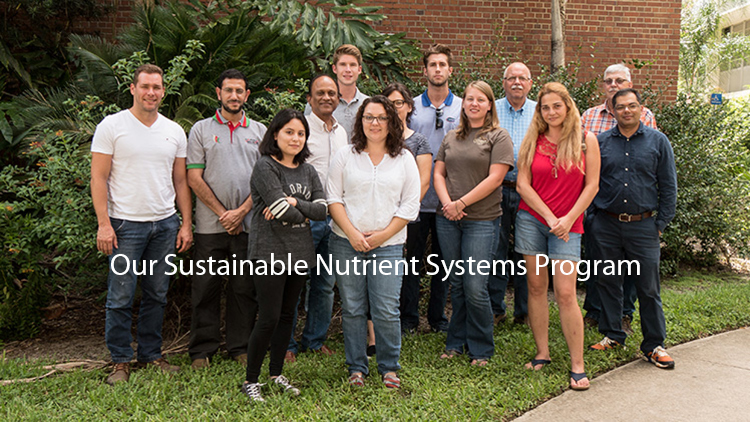Evaluating Effectiveness of Best Management Practice(BMP) for Animal Waste Fertilizer Management to Reduce Nutrient Inputs into Ground Water in Suwannee Basin, Phase I & Phase II
FAES Project Number: SWS-03865
D. A Graetz,
R. S. Mylavarapu, G. Hochmuth, W.Graham
Funding Agency – USEPA Sec 319 (through FDEP)
Duration - Short
Crop production, poultry production and dairy operations
Jaime Sanchez, Ph.D. student - dissertation
Jaime.F.
Sánchez and Rao S. Mylavarapu
Soil and Water Science Department
University of Florida, Gainesville, Fl 32611
Introduction
Water quality has been the subject of concern and attention in the Suwannee River Basin for a number of years. Recent data have indicated increasing concentration of nutrients in ground water, spring water, and private drinking water wells. This has brought a neede focus to agency efforts to find nutrient management soulitions to the problem. In addition, the state's participation in the Total Maximum Daily Load (TMDL) Program will require new initiatives for managing nonpoint sources (e.g. for nutrients) for agriculture, and for measuring the use and effectiveness of nonpoint source controls. As a result, public agencies and the agricultural community are taking the lead in implementing a watershed-based process for BMP development, demonstration, refinement, and implementation to reduce nutrient loadings to ground water and surface water, involving stake holders throughout the basin. These cooperators have formed the Suwannee River Basin Nutrient Management Working Group (SRBNMWG) and are preparing an overall basin agreement. Each cooperating agency will allocate certain resources toward development, implementation, tracking, and evaluation of BMPs under the agreement.
A number of programs have been launched in the Middle Suwannee River Basin (MSRB), a state nonpoint source (NPS) priority water body, a Unified Watershed Assessment Priority Restoration Water Body, and the District's top Surface Water Imporvement and Management (SWIM) priority water body, to improve water quality. These include projects funded by both state and federal sources. Federal projects have included a U.S. Deposrtment of Agriculture PL566 project, $1.36 million of previous Section 319 grant funded projects, and cooperative Natural Resource Conservation Service (NRCS)/IFAS projects (e.g., composting). State projects have included $4.2 million of SWIM activities and approximately $650,000 in Nitrate BMP research projects. In 1994, the Florida Lgislature passed the Nitrate BMP bill, which enacted a tax of $0.50 per ton on nitrogen fertilizer. Funds generated are used to fund research into practical BMPs to reduce nitrate contaminated drinking water wells. Under this program, and applicable to the MSRB, research is being/has been conducted into BMPs for watermelon, cucumbers, field corn, snap beans, potatoes, peppers, cotton, sweet corn, tomatoes, peanuts, sorghum, and container nursery operations.
To better address the surface and ground water quality concerns in the Lower Suwannee River Basin, the SRBNMWG has been formed. It consists of the following agencies and organizations:
Florida Department
of Agriculture and Consumer Services
Suwannee River Water Management District
Florida Agricultural and Mechanical University
Lafayette Soil and Water Conservation District
Natural Resources Conservation Service (NRCS)
Florida Cattlemen's Association
Florida Fertilizer and Agrichemical Association
Florida Poultry Federation, Inc.
Florida Septic Tank Association
Sunshine State Milk Producers
Florida Department of Environmental Protection
Florida Department of Community Affairs
University of Florida (IFAS)
Suwannee Soil and Water Conservation District
United States Geological Survey (Florida District)
Florida Farm Bureau Federation
Florida Forestry Association
Gold Kist
Florida Department of Health
In addition to the listed entities, the SRBNMWG is open to anyine or to any entity wiching to participate or contribute. The SRBNMWG was formed to help better coordinate the many ongoing water quality management activities and research efforts within the basin and to better promote strong partnerships between government agencies and the agricultural community. The SRBNMWG has established the following mission:
"Assess
sources of nutrient load to the Suwannee River Basin and optimize
reductions
in loadings to waters of the basin emphasizing voluntary, incentive-based
programs
for protecting the environment and public health."
Project Objectives
The objective of this project is to implement BMPs at the farm level
to reduce nutrient loadings to ground water from agricultural activities
and to evaluate their water quality effectiveness. This project
complements ongoing BMP implementation and evaluation activities
being funded through the USDA PL566 program, the SRWMD SWIM Program,
the DACS agricultural BMP cost share program, and the state's Nitrate
BMP program. It is hoped that the information gained from this project,
in conjunction with the other ongoing BMP implementation efforts,
will help to fulfill the SRBNMWG agreement's objectives for non-regulatory
approaches for reduicing nutrient loadings. This will be accomplished
through verification of BMPs via pre- and post-BMP water quality
demonstration monitoring, stakeholder education and information transfer, and data collection for future development of a users' tool for BMP selection and simulation.

Specific Objectives include:
1. Coordinate cooperative efforts to refine and evaluate agricultural BMPs that are being conducted by various agencies, agriculture, and universities in the Suwannee River Basin (SRB).
2. Improve working relationships and partnerships among the various agencies, agricultural interests, and the universities.
3. Implement BMPs for a row cropping farm, dairy farm, and poultry farm in the SRB.
4. Evaluate water quality impacts (primarily ground water) from a row cropping system, dairy farm, and poultry farm in the SRB.
5. Evaluate the water quality effectiveness of Best Management Practices (BMP) for a row cropping system, dairy farm, and poultry farm in the SRB.
6. Collect data from each system for the future development of a personal computer based users' tool for BMP selection and simulation.
7. Implement information sharing/educational program(s) using IFAS extension service, Soil and Water Conservation District, and public outreach to disseminate overall environmental impact awareness, types of BMPs for agricultural pratices, and the result of the BMPs being evaluated in this project.







